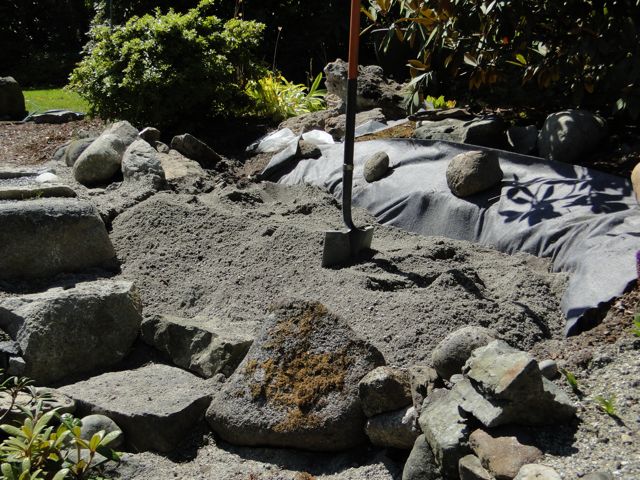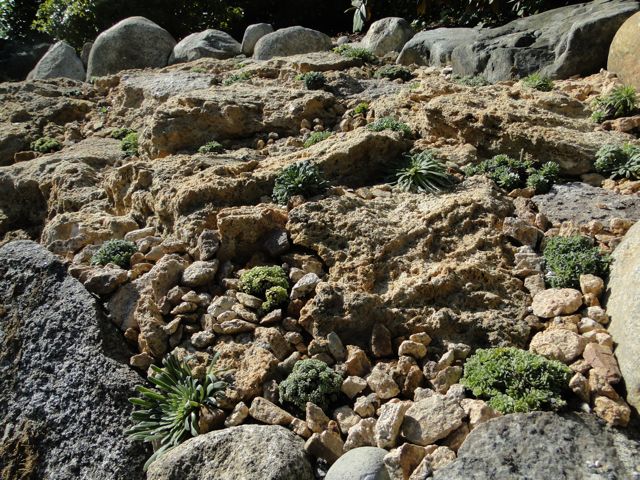Thanks to Rex Murfitt of Victoria BC I had over 50 silver saxes to plant out. Many of the plants are rare in Canada and include S. Monarch, S. Minima Glauca, S. St Johns, S. callosa Albert Albida, S. farreri, and S. burnatii.
I started by digging out the clay soil from a bank to a depth of about 2 feet. I backfilled with sand with a wide gradation from crusher fines up to quarter inch pieces. Some peat-based growing mix was worked into the sand- less than 10% of the total volume. I lined the uphill side of the excavation with landscape fabric to prevent nearby rhododendron roots getting into the bed and to discourage moles.
The rocks in the photos below are pieces of tufa laid out in a "crazy paving" pattern to create random crevices. I planted the saxes into the crevices and filled the crevices with pieces of tufa and small rocks that were tufa coloured. The end result I wanted was for the bed to look like one large broken rock outcrop with randomly spaced plants growing in cracks. Later I will also plant some saxes directly into the tufa.





Comments
Anne Spiegel
Re: New Silver Saxifrage Bed
Tue, 08/31/2010 - 2:15amDavid, thanks so much for the construction details. This is a great-looking bed now and it's going to be sensational as the plants take off. We seem to have identical approaches but I wish I had thought of the landscape paper to discourage tree roots. That seems like a really good idea. You mention using peat-based growing mix as 10% of volume - I use clay subsoil to try and get a little water-holding capacity in this very dry garden and then I add minerals and slow release fertilizer. But basically the approach is the same and the results seem to be quite good. Please keep sending pictures of this bed as it blooms.
Lori S. (not verified)
Re: New Silver Saxifrage Bed
Tue, 08/31/2010 - 9:53amThanks for posting such an excellent tutorial, David!
Wow, 50 saxes - an awesome number to us beginners! The bed looks terrific, and will only get better and better... yet another addition to your already superb garden (as I've seen from your postings over at SRGC, and your previous ones here).
Richard T. Rodich
Re: New Silver Saxifrage Bed
Tue, 08/31/2010 - 3:35pmI really like the style that you have chosen. I've never heard of using landscape cloth to stop root growth. Not that it won't work, I just don't know. Nevertheless, it would definitely prevent the native soil from creeping in and contaminating you prepared mix. And, since roots in general can have a hard time crossing strong delineations of soil types, the landscape cloth, in preserving such a delineation, might do the trick after all!
Sellars (not verified)
Re: New Silver Saxifrage Bed
Tue, 08/31/2010 - 9:00pmThanks Anne. Lori and Rick for your comments.
Several years ago I used landscape fabric to totally enclose a pure sand bed for growing Androsaces. The landscape fabric prevents incursions from moles and helps maintain a fungus-free zone. As long as you use a thick high-grade fabric it seems to work well. The saxes are not as fussy as Androsaces so I am not so concerned with native soil in the mix but landscape cloth definitely helps to exclude roots of nearby woody plants.
One of the issues with this type of bed is that it can get overwhelming when in flower. Silver saxes in flower really look best as single subjects rather than as massed plantings. Massed plantings can work well with other plants mixed in such as in the photo of Saxes and Lewisias below.
The close planting of silver saxes in the new bed is more for the year-round foliage interest than the profusion of flowers in May. I love the way the saxes creep over the tufa, especially the paniculata types.
Lori S. (not verified)
Re: New Silver Saxifrage Bed
Tue, 08/31/2010 - 9:23pmWow, gorgeous scenes!
Anne Spiegel
Re: New Silver Saxifrage Bed
Wed, 09/01/2010 - 5:30amBeautiful pictures, David. And yes, the saxes look great with other plants mixed in, very colorful.
Trond Hoy
Re: New Silver Saxifrage Bed
Wed, 09/01/2010 - 12:48pmVery well done, David. I don't know if I shall call it artistic or natural looking but it is something like that I try to achieve on my shed roof.
I have to grow Saxifrages of this type above ground or else they suffocate.
Richard T. Rodich
Re: New Silver Saxifrage Bed
Wed, 09/01/2010 - 4:45pmIt's hard to believe a silver saxifrage bed could be too flowery :o but I think I know what you mean. Nevertheless, it's really inspiring...
Do you use the heavy felt like landscape cloth or the plastic woven type (or something else)?
Sellars (not verified)
Re: New Silver Saxifrage Bed
Thu, 09/02/2010 - 7:16pmRick:
I use the heavy felt cloth - basically the highest grade landscape fabric available at the local hardware store. If you wanted something stronger you could source geotextile, an even heavier fabric used in the construction industry. It might be available at a landscape outlet.
I have found the lighter landscape fabric eventually rots in our climate, particularly if it is laid directly onto wet clay soil. A drainage layer under the fabric will increase its longevity.
Todd Boland
Re: New Silver Saxifrage Bed
Sat, 09/04/2010 - 5:53amBeautiful layout David!
Rex gave me a bunch of silver saxes when we hosted the NARGS Annual meeting...alas many have died but I still have a few such as Monarch, callosa, paniculata 'Hirtifolia', Dr. John and a couple of others whose names I forget. The encrusted are probably the easiest ones to grow here.